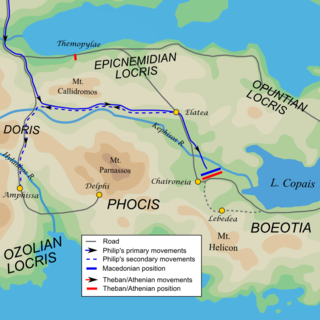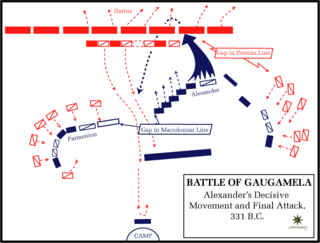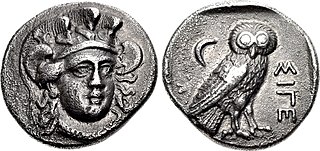
The 5th century BC started the first day of 500 BC and ended the last day of 401 BC.
Year 347 BC was a year of the pre-Julian Roman calendar. At the time it was known in Rome as the Year of the Consulship of Venno and Torquatus. The denomination 347 BC for this year has been used since the early medieval period, when the Anno Domini calendar era became the prevalent method in Europe for naming years.
Year 346 BC was a year of the pre-Julian Roman calendar. At the time it was known as the Year of the Consulship of Corvus and Visolus. The denomination 346 BC for this year has been used since the early medieval period, when the Anno Domini calendar era became the prevalent method in Europe for naming years.
Year 408 BC was a year of the pre-Julian Roman calendar. At the time, it was known as the Year of the Tribunate of Iullus, Ahala and Cossus. The denomination 408 BC for this year has been used since the early medieval period, when the Anno Domini calendar era became the prevalent method in Europe for naming years.
This article concerns the period 349 BC – 340 BC.
This article concerns the period 389 BC – 380 BC.
This article concerns the period 359 BC – 350 BC.
This article concerns the period 339 BC – 330 BC.
Year 263 BC was a year of the pre-Julian Roman calendar. At the time it was known as the Year of the Consulship of Mesella and Crassus. The denomination 263 BC for this year has been used since the early medieval period, when the Anno Domini calendar era became the prevalent method in Europe for naming years.

Year 338 BC was a year of the pre-Julian Roman calendar. At the time it was known as the Year of the Consulship of Camillus and Maenius. The denomination 338 BC for this year has been used since the early medieval period, when the Anno Domini calendar era became the prevalent method in Europe for naming years.
Year 335 BC was a year of the pre-Julian Roman calendar. At the time, it was known as the Year of the Consulship of Calenus and Corvus. The denomination 335 BC for this year has been used since the early medieval period, when the Anno Domini calendar era became the prevalent method in Europe for naming years.

Year 331 BC was a year of the pre-Julian Roman calendar. At the time, it was known as the Year of the Consulship of Potitus and Marcellus. The denomination 331 BC for this year has been used since the early medieval period, when the Anno Domini calendar era became the prevalent method in Europe for naming years.
Year 330 BC was a year of the pre-Julian Roman calendar. At the time, it was known as the Year of the Consulship of Crassus and Venno. The denomination 330 BC for this year has been used since the early medieval period, when the Anno Domini calendar era became the prevalent method in Europe for naming years.
Year 387 BC was a year of the pre-Julian Roman calendar. At the time, it was known as the Year of the Tribunate of Papirius, Fidenas, Mamercinus, Lanatus and Poplicola. The denomination 387 BC for this year has been used since the early medieval period, when the Anno Domini calendar era became the prevalent method in Europe for naming years.
Eubulus was a statesman of ancient Athens, who was very influential in Athenian politics during the period 355 BC to 342 BC and was notable for his abilities in managing Athenian finances.

Chares of Athens was a 4th-century BC Athenian military commander (Strategos), who for a number of years was one of Athens's foremost commanders. He was also a well connected politician enabling him to procure the commands he desired, commands he primarily used to enrich himself and his adherents.

The Second Athenian League was a maritime confederation of Greek city-states that existed from 378 to 355 BC under the leadership (hegemony) of Athens. The alliance represented a partial revival of the Delian League, which had been disbanded in 404 BC following the defeat of Athens in the Peloponnesian War. The new League was centered in the Aegean and included over 60 states, among which were Kos, Mytilene, Rhodes, and Byzantium. It was primarily formed as a defensive alliance against Sparta and secondly the Persian Empire. The new League's main objective was to preserve peace in Greece and counterbalance Sparta's growing hegemony and aggression. The League largely revived Athenian influence in the Greek world, reestablishing it as the strongest naval power in the eastern Mediterranean. This time, Athens made conscious efforts to avoid the strict terms that had eventually rendered the previous Delian League unpopular. The alliance lasted until 355 BC, when most of the allied cities became independent following the Social War that broke out in 357 BC.
Hermias of Atarneus was a Greek tyrant of Atarneus, and Aristotle's father-in-law.
The Theorica, also called the Theoric Fund or Festival Fund, was the name for the fund of monies in ancient Athens expended on festivals, sacrifices, and public entertainments of various kinds. The fund was, in certain circumstances, also distributed among the people in the shape of largesses from the state.

The Great Satraps' Revolt, or the Revolts of the Satraps, was a rebellion in the Achaemenid Empire of several satraps in western Anatolia against the authority of the Great King Artaxerxes II. The Satraps who revolted were Datames, Ariobarzanes, Orontes, Autophradates, and Mausolus. The timing of their revolts varied, as did the circumstances that induced them to rebel. Though often portrayed as a general uprising, there was little coordination among them and at no time did they actually threaten Artaxerxes directly. Their efforts were aimed at secession rather than a takeover of the Empire.





